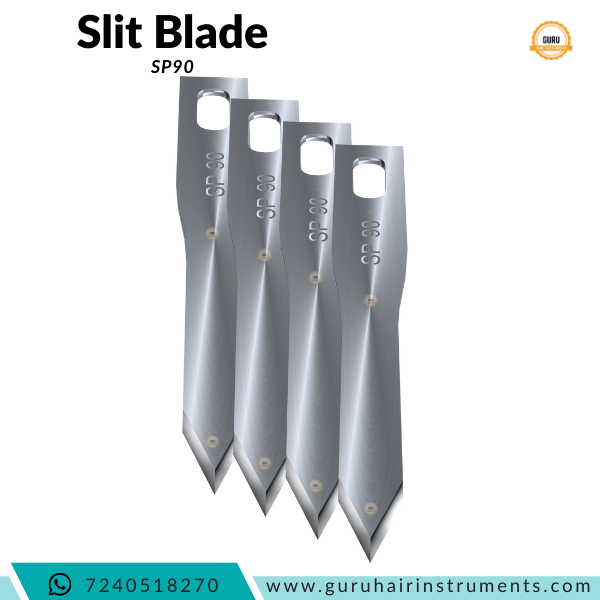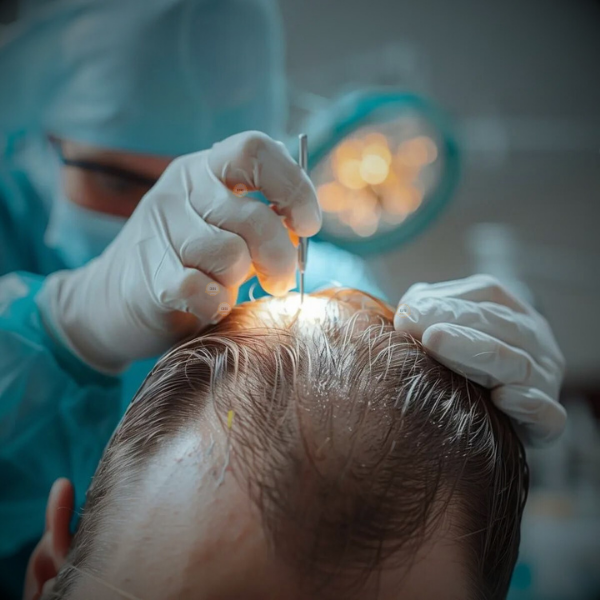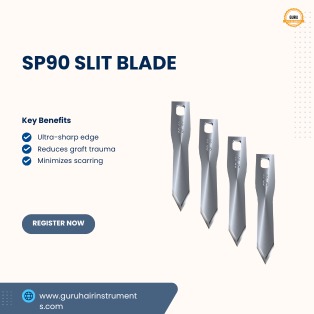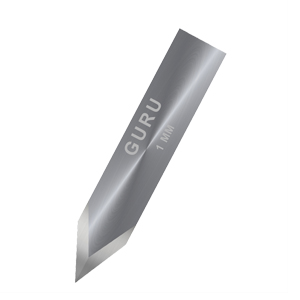A FUE (Follicular Unit Extraction) Slit Blade is a surgical blade used to make the recipient (slit) sites in the scalp during hair transplant procedures. After follicles are extracted (in FUE), these slits are made where the grafts will be placed. The blade must allow precise incisions of specific size, depth, direction, and angle so that grafts sit naturally, heal well, and the final hairline looks natural.
What is a slit blade?
A slit blade is the tiny surgical blade/knife used to create the recipient-site “slits” (incisions or tunnels) in the scalp where follicular unit grafts are implanted. The blade controls slit width, depth, angle and orientation — all crucial to natural hair direction, graft fit, and final density. Rejuvenate Admin+1
Common types of slit blades
- Sapphire blades — made of a sapphire tip (very hard, very sharp); allow very fine, narrow slits for tighter packing and crisp angulation. Wimpole Clinic+1
- Stainless steel / carbon steel blades — standard, economical, sharp; many disposable options. surgimeddevices.com+1
- Chisel / rectangular blades — create wider, more rectangular slits; used when a certain graft shape/fit is desired but can be more traumatic if misused. Hair Transplant Los Angeles
- Semiconical / tapered blades — aim to reduce dermal trauma by creating a conical entry that protects deeper vascular plexus. Clinical work suggests semiconical designs can reduce damage vs rectangular blades. PubMed Central
Typical sizes & selection
Blades are available in very small widths to match grafts: common widths range from ~0.6 mm up to 1.5 mm (smaller for single-hair grafts, larger for multi-follicular units). Choose width by graft size, desired density, and skin thickness. Alibaba+1
Advantages of using slit blades (when done right)
- Precise control of angle & direction (coronal vs sagittal vs lateral slits). ISHRS Hair Transplant Forum
- Ability to create very narrow slits (especially sapphire) for denser packing. Wimpole Clinic
- Faster pre-slit workflows in large sessions — good for planning and density mapping. Rejuvenate Admin
Caution
- Risk of shock loss or trauma if blades are too sharp/wide or if slits touch adjacent grafts — particularly with very sharp chisel blades. Hair Transplant Los Angeles
- Blade depth/width mismatch to graft size can cause compression, poor fit, or vascular damage. PubMed Central
- Reusable blades lose consistency; many clinics prefer single-use/disposable to maintain sharpness and sterility. newvisionmeditec.en.made-in-china.com+1
Practical tips for surgeons/clinics
- Match blade width to graft width — test a few slits and try a micro-implant test fit before full implantation. Hasson & Wong
- Decide slit orientation by desired outcome: coronal for natural frontal hair flow and consistent angulation; sagittal can be faster in some zones — both have trade-offs. ISHRS Hair Transplant Forum
- For dense packing use very fine sapphire blades and controlled depth — reduce downward force and avoid “overslit.” Wimpole Clinic
- If switching blade types mid-case, recheck angulation, width, and depth on a test slit to avoid irregularity.
- Store/handle sapphire tips carefully — brittle vs steel — and follow vendor reuse recommendations (some sapphire blades are reusable a few cases, some are single-use). newvisionmeditec.en.made-in-china.com
Sterilization & procurement
- Many high-quality blades come as single-use sterile packs (preferred for consistency). If reusable, follow strict autoclave cycles and vendor guidance to retain edge geometry. Check blade material (sapphire vs stainless vs carbon steel) as that affects reusability and sterilization protocol
Advantages of Guru Slit Blades – Click here for order
Ultra-Sharp Edges
- Guru says the blade’s cutting edge penetrates the skin “like butter.” Guru Hair Instruments+2Guru Hair Instruments+2
- Ultra sharp edges reduce resistance while making slits. Guru Hair Instruments+1
- High Durability
- A single blade can make 4,000–5,000 slits before needing replacement. Guru Hair Instruments+1
- This implies fewer blade changes mid-procedure, more consistency (blade wear causes variability), cost savings.
- Range of Sizes
- Available in many sizes: 0.90 mm, 1.00 mm, 1.10 mm, 1.20 mm, 1.30 mm, 1.40 mm, etc. ExportersIndia+1
- Having multiple widths allows matching incision size to the graft, improving fit, reducing trauma.
- Material Quality
- Stainless steel (grade ~420) used. Guru Hair Instruments+1
- They say finishing is polished and the tip shape is “diamond.” Ultra sharpness. ExportersIndia+1
- Design Angle / Tip Shape
- Some blades have special tip shapes (diamond shape tip, spear-point, four-sided spear point) designed for smoother, lesser resistance slits. ExportersIndia+2Guru Hair Instruments+2
- Diplacement of resistance means less pulling, tearing, better graft placement.
- Patient Comfort / Healing
- Because cuts are sharper, cleaner, smaller, trauma is less; leads to less pain post-op, fewer complications, faster healing. Guru Hair Instruments+1
- Also smaller or cleaner incisions lead to lower visible scarring. Guru Hair Instruments+1
- Cost / Value
- The price is “pocket-friendly” according to their description. Given durability (higher number of slits per blade), cost per slit drops. Guru Hair Instruments+1

 FUE Punch – best hair transplant punch
FUE Punch – best hair transplant punch




